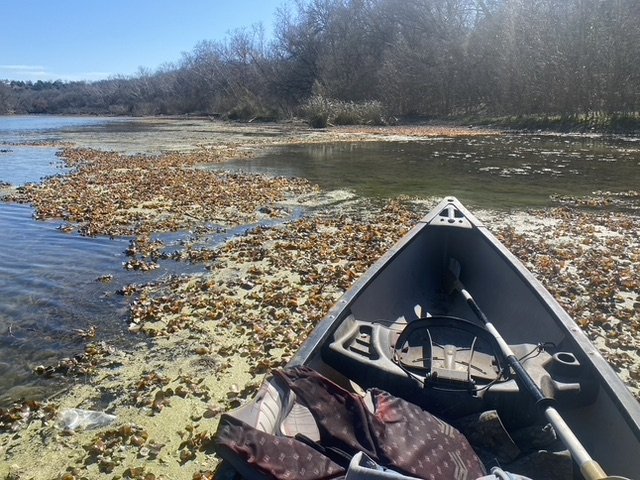River Impaired Case Goes Before Adminstrative Judge
Colorado River along the shore of McKinney Rough Nature Park where wastewater facility wants to increase effluent from 50,000 to 510,000 gallons per day
AUSTIN, TX — A contested case hearing scrutinising major changes to a wastewater facility in Bastrop County concluded Tuesday with conflicting opinions on the health of the Lower Colorado River below Austin. The outcome of the case could have significant ramifications for how the river’s water quality is monitored, whether Texas is following EPA guidelines, and if higher standards might be required for wastewater permitting.
Rebecca Smith, presiding judge for the State Office of Administrative Hearings, oversaw testimony on a contested permit application for Corix Utility’s wastewater facility in McKinney Roughs Nature Park, about 30 miles downstream of Austin. The executive director of the Texas Commission on Environmental Quality has approved the permit, which would upgrade the facility and increase treated effluent into the river from its current limit of 50,000 gallons per day up to 510,000 gallons. Environmental Stewardship, a Riverkeeper non-profit that has been working to protect the river for more than 20 years, requested — and was granted — the contested case hearing.
It was two days focused on the complicated science of water-quality monitoring and regulatory rule-making. Cross examination ranged from the impact of nutrients on algae growth to what baseline to use when evaluating the river’s health and the models used to evaluate wastewater permit applications. In the coming months Smith will make a recommendation to the Texas Commission on Environmental Quality on whether to deny, approved, or modified the Corix application.
Environmental Stewardship, the plaintiff in this case, provided data analysis and expert testimony to back up its assertion that the river between Austin and LaGrange is impaired to the point it can no longer handle more wastewater without further damaging what appears to be river in declining health.
“The status of the Colorado River is alarming as it faces the threat of being overwhelmed by silt and wastewater from rapid growth and development,” says Steve Box, executive director of Environmental Stewardship. “It is our responsibility to advocate for the preservation and protection of our precious waterways, ensuring a thriving environment for current and future generations.”
Environmental Stewardship is among several dozen advocacy groups petitioning EPA to evaluate whether TCEQ has been lax in upholding the Clean Water Act in its waterways.
At stake is not only the Corix plant expansion but whether the TCEQ has adequately and accurately monitored and assessed this portion of the river for the past 20 years. Once a river or stream has been designated “impaired,” TCEQ must take remedial action — an anti-degradation management plan — to restore its status. After a historic legal battle that forced Austin to upgrade its wastewater facilities nearly 40 years ago, the state legislature designated this section of the river as having “exceptional” water quality. Environmental Stewardship contends that TCEQ has failed to hold the river to that higher standard through through lack of resources and adequate monitoring, despite the rapid expansion of development along the river corridor that has gone into overdrive since Elon Musk’s three companies relocated along the river. Expert testimony focused on whether excessive nutrient levels, silt, and algae have resulting in depleted aquatic life and impaired recreational use.
Richard Martin, an Environmental Stewardship member and long-time fisherman of this segment of the river, testified that the river’s fish population has been compromised.
“I have observed a major decline in fish populations in the area of the Colorado River between Webberville and Bastrop over the last 50 years,” Martin said in his deposition. "I have witnessed a more drastic decline over the last four years.”
While not a landowner along the river, Martin was granted status as an affected party in the contested case because he depends on the river for recreation. Under current interpretation, TCEQ recognises only parties living within a mile downstream or adjacent to wastewater facilities as having standing to contest a wastewater permit.
Martin is a frequent visitor to Wilbarger Bend, where in 2001 the LCRA park built and operated the small wastewater plant to service its facility. LCRA sold all its wastewater facilities to Corix in 2014. In addition to the park, the McKinney Roughs plant has been servicing Cedar Creek Junior. High School on the other side of Highway 71. Corix states it needs to expand the plant to upgrade the facility, which has received numerous violations, and provide service for up to 2,000 new customers, including a nearby apartment complex under construction. A week before the permit’s comment period expired in early 2023, Environmental Stewardship asked its state representatives to request a public meeting to give the public a chance to comment.
Rambo Materials, latest sand and gravel mine to move into Wilbarger Bend. Mining 50 feet from river channel.
Comments from that meeting included concerns of increased noise and odour, negative impacts on river water quality, and why the utility couldn’t build the new facility outside the park. Corix says a move out of the park was not feasible and went ahead with construction last year, despite TCEQ rules that it could not start until the permit was approved. The company was issued a “minor” violation for that infraction three months ago.
Experts for both Corix and Environmental Stewardship differed over opinions on the threat an increased discharge from the plant would have on aquatic life, as well as swimming and fishing. LCRA’s latest monitoring of water quality and aquatic life — unpublished and not yet approved by TCEQ —showed that neither of its two testing sites in this section of the river met exceptional standards for all testing parameters.
A critical point of contention during the hearing was whether TCEQ is required to make its determination of the permit’s impact based on the river’s current conditions or an earlier baseline. Environmental Stewardship attorney Eric Allmon attempted to show that TCEQ permit evaluators failed to follow the finer points of the Texas EPA surface water quality regulations. He questioned TCEQ staff at length as to why they had not looked at reported degradation of the river based on its conditions going back to 1975. TCEQ results first labeled levels of nutrients in this section of the river as a “concern” in 2002. No comprehensive aquatic life studies in this section of the river were undertaken until this past year after Environmental Stewardship publicised that gap in monitoring
Dr. Lauren Ross, an expert witness for Environmental Stewardship, questioned why TCEQ modelling estimated only 10% of river flow below Long Horn Dam was composed of wastewater. The agency failed to consider existing wastewater discharges into the river above Austin, she added. By her calculations, more than 60 of river water at critical low flow periods is treated wastewater. While some upstream nutrients are taken up by algae, nitrate and phosphorus are not eliminated when algae decomposes, she added.
Dr. Stuart Price, a consulting water quality expert for Corix, dismissed the potential harm of excessive algae on aquatic life, while noting there is no limits imposed by TCEQ rules on nitrogen levels in wastewater.
“I see some algae in places, but so what?” he said at the hearing, adding that a study of Hill Country streams showed algae growth was beneficial to aquatic life. Price did recall that excessive plant growth in the Austin area was a concern in the late 80s and early 90s “but it was resolved. These problems are not unsolvable.”
Last year, it was an invasion of algae and aquatic plants that led landowners along the San Gabriel River to contest a permit renewal for the Liberty Hill wastewater plant. The TCEQ commission voted in support of the administrative judge’s recommendation to amend the permit and reduce discharge phosphorus levels from 0.15 milligrams per litre to 0.02 milligrams per litre. The city is appealing the decision, contending the lowered limit is financially prohibitive. The Corix permit would allow 1.0 milligrams per litre of phosphorous to be released into the Colorado river at McKinney Roughs.
Current technology is available to meet that more stringent phosphorous screening requirement, Ross said. TCEQ staff that worked on the permit application questioned whether on more stringent screening would impact “recalcitrant phosphorus” which is biologically harder to assimilate in receiving waters. All types of phosphorous can be removed through reverse osmosis but it can be financially prohibitive, said TCEQ engineer Karla Kinser.
Cross examining of three other TCEQ staff members who worked on the Corix permit revealed how little, if any, local characteristics unique to smaller wastewater operations are considered when evaluating a permit application.
Indeed, several TCEQ staff under cross examination said they relied on TCEQ’s annual reports for the river basin in evaluating the permit application rather than on-site inspections. Allmon Illustrated one example of how that approach miscalculated local characteristics of the McKinney Roughs’ tributary, which runs down a mostly wooded, steep, and narrow channel in the park. He pressed TCEQ’s James Michalk on his calculations of the size of that mile-long tributary that feeds wastewater into the river.
Lacking physical access to the tributary or more specific data provided by Corix, TCEQ relied on default calibrations in evaluating the tributary’s capacity to handle wastewater load. Those calibrations put on the tributary’s average dimensions at 24 feet wide and six inches deep. Permit application photos of the tributary’s outfall into the river showed it running through a foot-wide culvert while another photo of the tributary indicated a much narrower stream bed. Michalk agreed with Allmon’s assertion that significant differences in the real versus calculated dimensions would impact the tributary’s capacity to dilute nutrients coming out of the plant before reaching the river.
With much of the hearing focused on evaluating two photos of the river near the Corix plant outfall, the impact of algae and plant growth in the river was argued over on both sides. Price attributed the seemingly high coverage of plant growth visible on the photos as the result of stagnation from low river flows.
“I see them more as the result of no flushing flows to cleanse substrates,” he said, noting that January is typically a low-flow period.
Ross, however, was more confident in attributing the overgrowth to high nutrient levels, especially phosphorous, to their proximity to the wastewater facility’s outfall, which is on park property not far from where visitors fish and swim.
The hearing concluded with Allmon cross examining Price on his testimony for a recent lawsuit the Texas attorney general has filed against 3M and two other chemical companies for covering up the threat to human health from PFAS or forever chemicals. Texas has not added these chemicals to drinking water standards despite the EPA giving water utilities notice that they need to have a remediation plan in place by 2027. Allmon submitted testimony from a Texas State toxicologist that warned the city of Bastrop’s drinking water could be more at risk of infiltration with PFAFs from upstream wastewater if not adequately screened in the future.


